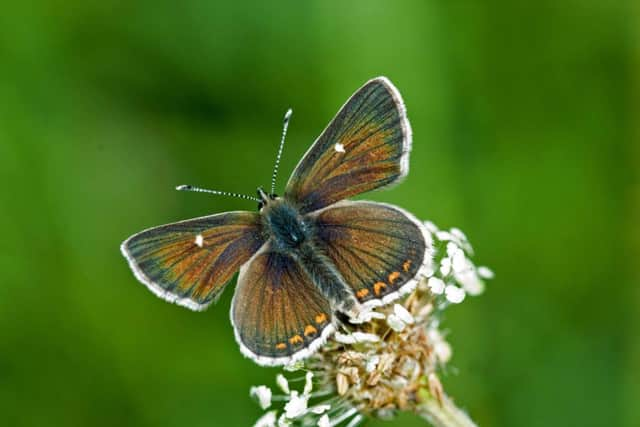Arson attack threatens rare Scottish butterfly


Conservationists fear the fire could have wiped out a vulnerable colony of northern brown argus butterflies at Kincraig Point, near Earlsferry in Fife.
They say the blaze, which occurred on 2 October and destroyed part of the conservation site, came at the worst time of the year for the butterfly – just as the caterpillars were preparing for hibernation on the ground below vegetation.
Advertisement
Hide AdAdvertisement
Hide AdThe most recent count identified 33 of the insects at the site in 2013, but the fire could prove catastrophic for next year’s population.
Paul Kirkland, director of the charity Butterfly Conservation Scotland, said: “It is surprising that invertebrates can sometimes survive fires, but it all depends on whether the caterpillars have already gone down into hibernation and how deep the fire has burned.
“However, the weather has been so warm and mild that caterpillars have been found still feeding in some areas as recently as early October.
“This makes it quite possible that the fire has done some damage – it is really bad luck for the northern brown argus.
“The vast majority of these butterflies exist in Scotland, so we have a special responsibility for them.
“It’s one of the species we think might be affected by climate change, so we’re already quite concerned about it.
“Luckily, the Kincraig site is monitored, so we’ll be able to tell how badly it has been affected.”
The northern brown argus – Aricia artaxerxes – relies solely on a plant called common rock-rose that lives on sunny grassland, cliffs and rocks. The low-growing yellow-flowered shrub carpets the slopes at Kincraig in summer.
Advertisement
Hide AdAdvertisement
Hide AdGavin Johnson, operation officer for designated sites at Scottish Natural Heritage (SNH), said: “It will be an anxious wait to see how the butterflies and the common rock-rose recover next year.
“We hope the fire damage will not seriously impact the future of this population of northern brown argus butterflies, but there could be disastrous results for this rare butterfly.”
The butterfly occurs in small, scattered colonies in Scotland and northern England. Populations south of the Border have declined dramatically.
The site is one of only five special areas in Scotland where the species is a “notified feature”, though they are found in smaller numbers elsewhere.
Fife Coast and Countryside Trust (FCCT) expressed concern over the incident.
“The Fife coastal path runs through this area and its stunning views and seasonal displays of wild flowers make it one of the most scenic sections of the whole route,” said FCCT’s Deirdre Munro.
“Not only has this been damaged but it is deeply worrying that local populations of rare and beautiful species such as the northern brown argus may also have suffered.
“In addition, activities which may simply appear to be mischievous such as rolling straw bales downhill or setting them alight may in fact be placing walkers in real danger.”
Police are investigating the circumstances behind the blaze, which burned 2.5 hectares at a site of special scientific interest on the Fife coastal path.